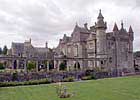

- Reiver names
- Hermitage Castle
- Sir Walter Scott
- [Abbotsford]
- football match
![]()
Abbotsford
 |
Abbotsford |
When the Scott family first moved to Abbotsford in 1812, they lived in a small farmhouse named Cartleyhole. In 1822, Sir Walter pulled this down and built an imposing mansion with turrets, battlements and a gateway fit for a castle. In the entrance hall and armoury is a fine collection of arms and armour, including a sword with a calendar of saints' days engraved on the blade.
Among the paintings in the drawing room are Raeburn's portrait of Sir Walter and a delightful study of his dog, Ginger, by Landseer, In the south courtyard stands a sculpture of his deerhound Maida, which served as a mounting block. Maida died in 1824 and lies buried beneath the effigy.
During Sir Walter's lifetime, Abbotsford was visited by, among many others, the novelist Maria Edgeworth, William Wordsworth and Washington Irving. After he died in 1832 (in Abbotsford's dining room), tourists came in ever-increasing numbers, including Queen Victoria who had tea with the family in 1867.
The drawing of Mucklemouth Meg (by Charles Kirkpatrick Sharpe) is on the east wall of the anteroom to the armoury.